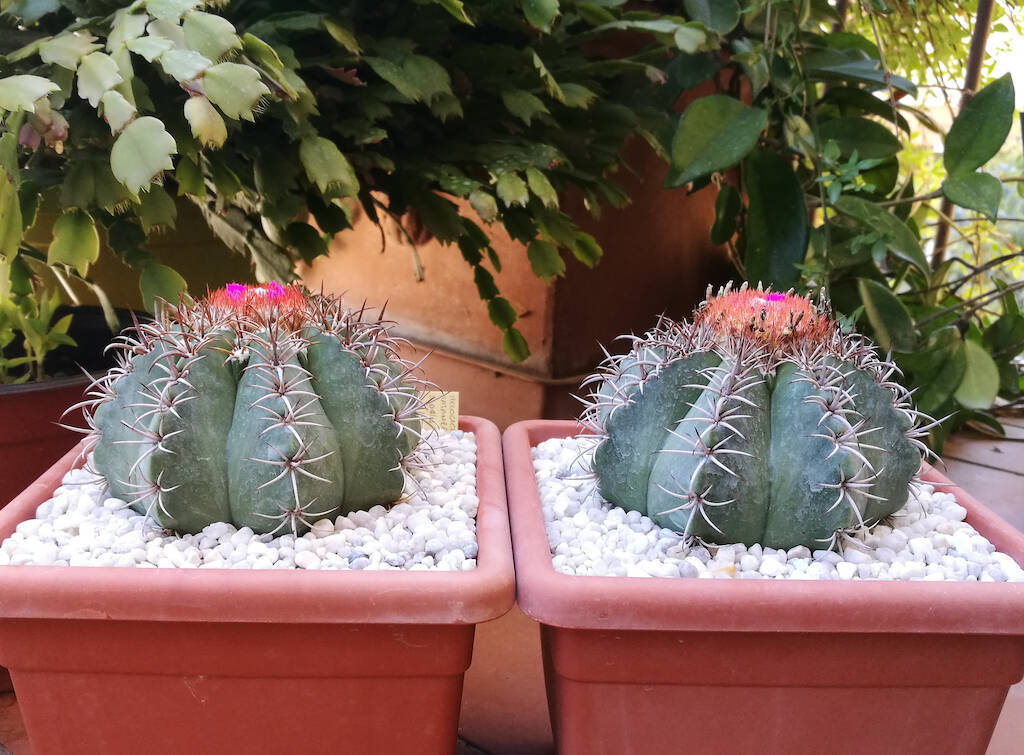In the great botanical family of the Cactaceae the Melocactus represent a small “case apart”. In fact, these are cacti with a traditional globular shape tending towards a shorter cylinder as they age, but they have a peculiarity: over the years they “put on their hats”. In other words, the apex of these plants stops growing and a sort of “headdress” takes shape in its place, made up of a compact fluff mixed with thick and very thin thorns, usually red but sometimes white. This is the cephalium and this is where the flowers and fruits will come from. In a very bizarre way, over time it is only the cephalium that grows in height, so much so that the stems remain the same size, while the “hat” stretches towards the sky, giving these plants a truly unique appearance. The “however” of this story lies in the ease with which these cacti lose their roots and, even if they have not been affected by rot or parasites, they start to die. In other words, a Melocactus in full health often begins to slowly deteriorate and die, perhaps even taking two years, just because the root system has gone haywire and the plant has not been able to produce a new one.
Those who have been cultivating cacti for some time know it well: Melocactus are as fascinating as they are “capricious” and you have to come to terms with it. In this article we deepen the knowledge with this genus, in particular from the point of view of the needs, so as to grow robust specimens and limit losses as much as possible. (…)
Introduction
It is usually said that Melocactus and Discocactus (similar genus in some ways) are plants that are loved and hated at the same time. Yes, because if in fact Melocactus have their own undoubted charm, at the same time they are among the most mangy cacti to cultivate. Or rather, all things considered, cultivation is not difficult, the fact is that these plants have a marked “tendency to suicide”: having reached a certain stage (almost always when they have formed the cephalium) they tend to lose their roots and only in rare cases they manage to reform the root system, unlike what happens with most cacti. In summary, it can be said that until Melocactus do not develop the cephalium, they have the same needs as other cacti and are not difficult to grow. Once the cephalium is formed – which is their characteristic element – they become extremely delicate plants, they cannot bear repotting and do not tolerate low temperatures. All this in cultivation, since these plants abound in nature and manage to be quite long-lived.
Distribution and history
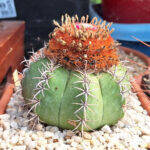
Fundamental, as for all plants, is the knowledge of the area of origin of this genus, knowledge that can provide useful data for the cultivation of these plants. Well, all Melocactus are native to the warm areas of the American continent, in particular south-western Mexico, the Antilles, Cuba, Colombia, Venezuela, Peru, Ecuador and, above all, Brazil. It follows that these are cacti originating from the central belt of the continent, where temperatures are warmer than, for example, those of the American states or northern Mexico. It is precisely for this reason that Melocactus do not tolerate the cold, unlike most other cacti (except for epiphytes).
From a historical point of view, the Melocactus mark a starting point in the story of the study of cacti, since according to many sources, these plants were the first cacti encountered by Europeans during their expeditions to the Americas at the end of the fifteenth century. As far as it turns out, Christopher Columbus himself observed some specimens in the West Indies, precisely in conjunction with his landing on the American continent. It is clear that for Europeans, who did not know cacti in any way since these plants originate exclusively from the Americas, from a botanical point of view that meeting represented an enormous surprise. It is no coincidence that several specimens of these plants were sent to Europe to be subjected to in-depth studies (and it is to be assumed that only a very few specimens torn from their habitat arrived overseas alive and even those few, if equipped with a cephalium, lasted a few months).
If you want to learn more about the distribution of cacti and succulents in the world you can consult this article, complete with maps.
As further confirmation of what is reported by the sources, there would be the fact that the very name attributed to these plants would probably be the origin of the word “cactus”, deriving from the Greek “kaktos“. The latter term had actually been in use for some time to generically indicate thorny plants such as thistle or artichoke and on the occasion of the Melocactus discovery it was decided to keep it, simply by having it preceded by the terms “melon” (i.e. melon) and “ekinos” (i.e. “curly”, or “thorny”). It follows that the first Melocactus were classified as Echinomelocactus, a term later shortened to Melocactus. The first scientific descriptions of this kind date back to several centuries after the discovery, i.e. in the mid-eighteenth century and are by Carlo Linnaeus, botanist and “father” of modern scientific classification. In particular, Linnaeus described 22 species of Melocactus in his famous Species Plantarum, published in 1753. Over the years, many studies followed one another and today this genus has around thirty species in all.
A short description
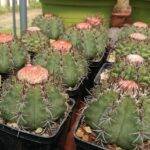
Regardless of the species, Melocactus are plants with a globular habit, tending to become short-cylindrical with age. The stems are solitary and have no tendency to bunch or shoot, except as a result of trauma. The dimensions of these plants can be defined as medium and range from twenty centimeters in height of M. matanzanus (the smallest and earliest species to form the cephalium) up to one meter in height, without however counting the cephalium, which can reach about thirty centimeters in the oldest specimens. The stems are generally bright green to dark green in colour, but do not lack the bluish tinge typical of the azureus species. The bodies of the plants are divided into very marked ribs capable of thinning or expanding (“accordion”) depending on the quantity of water present in the stem. The spines vary according to the species: they form at regular intervals along the coasts, they are always pointed and never hooked, slightly curved downwards. In some species they can be robust and short, in others thin and up to ten centimeters long (M. ernestii). The color of the thorns is usually white, tending to gray over time (except in some species, where the spine is brown).
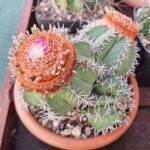
The analysis of the root system is interesting, probably this is the real weak point of these plants. The roots of Melocactus are usually underdeveloped, fibrous in the part close to the stem. Here is what George Thomson notes in his volume “Melocactus” published by Cactus&Co Libri (2009): “This means that even modest damage in the first few centimeters of the root can lead to the loss of the entire root“. And this could actually explain why, once the cephalium has formed, it is advisable to avoid repotting these cacti. Thomson observes again: “The roots are very sensitive and the plants lose them easily in case of prolonged periods of drought or in conditions of stagnant water”.
The cephalium
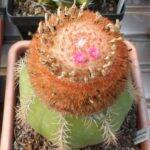
As we have seen, the cephalium represents the element that distinguishes this genus, although over time other genera of cacti also form what is called “false cephalium” (for example the Discocactus). In Melocactus the cephalium represents the watershed that separates the “juvenile” age from the maturity of the plant, i.e. the moment in which the latter is able to flower, produce fruit and therefore reproduce. Before the formation of the cephalium, the Melocactus develop the stem, which almost always takes on a short-cylindrical shape with age. The Melocactus produces offshoots very rarely and generally do so following an arrest in growth caused by a parasitic attack or, in any case, following a trauma sustained during growth, in particular at the vegetative apex. Once the adult stage is reached, after six or seven years in the earliest species (M. matanzanus) or after at least ten years in other species, the stem stops growing and the plant concentrates its energies on the production of the cephalium, which it forms at the apex of the plants and is composed of short, bristly and thick hair, usually red or white. From this moment on, only the cephalium will grow, which in some species reaches 4-5 centimeters (M. bahiensis), and in others it can reach twenty centimeters (M. peruvianus), giving the plant a bizarre appearance. Here is what George Thomson writes about it in the aforementioned “Melocactus – care and cultivation”: “It has been demonstrated that a large part of the stem of a mature Melocactus comprises only juvenile tissue with a transparent epidermis, and the adult tissue, without stomata, is mostly confined to the central nucleus of the cephalium. This juvenile tissue in the stem of melocactus is probably the reason why it is very difficult, though not impossible, to revive a plant that has lost its roots”.
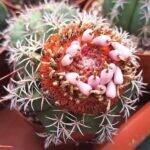
It is from the cephalium that, during the summer, the flowers are formed, which are tiny in size and vary in color from pink to magenta, and subsequently the fruits, which appear in the form of oblong, smooth, white, pink or red. The growth of the cephalium in height is annual and in some cases it is possible to observe the layers which make evident the annual development of this curious organism. Finally, in some specimens, it is possible to observe the dichotomization of the cephalium, i.e. its division into two distinct parts according to a phenomenon common to other cacti, in which the vegetative apex can divide (dichotomize precisely) and give life to two distinct “heads” (the phenomenon often occurs in Mammillaria parkinsonii, for example).
Cultivation
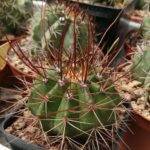
Fascinating, particular, bizarre but “touchy” plants, Melocactus are certainly not among the simplest cacti in terms of cultivation. Their life and consequently the level of cultivation can be divided into two phases: pre-cephalian and post-cephalian. Before the formation of the cephalium the Melocactus can be treated exactly like most cacti and also tolerate minimum winter temperatures close to zero Celsius degrees. Once the cephalium has formed, cultivation becomes more demanding: the plants no longer tolerate repotting, unless you simply remove the plant from the old container to gently insert it into a new pot without touching the roots (even in these cases, however, some specimens can go into stress and stop growth). Furthermore, since the plant has reached the adult stage, it is advisable to avoid the winter cold and the Melocactus, from mid-October to the end of April, must be placed in environments sheltered from the rain and where the minimum temperatures do not drop below 15-16 degrees. They can also be placed in the apartment, in a bright place, but they must be watered in moderation no more than once a month and only to prevent the root system from drying out completely. If the stem does not show signs of suffering (in other words if it remains swollen and turgid) it is also possible to limit winter watering to once every two months, so as to further reduce the risk of collar rot.
As far as the substrate is concerned, whether the plant is still young or has a cephalium, the situation does not change and the Melocactus need very draining and light soils. You can use the tested mix based on peat, pumice and lapilli in equal parts (possibly reducing the peat part and increasing the pumice or adding river gravel or quartzite), or you can create a substrate starting from common clay (a maximum of 20%) by adding a little sand, a little peat (10%) and for the remainder various inert materials such as pumice, gravel or quartzite.
No particular indications regarding watering and fertilization: during the growing season, Melocactus (with or without cephalium) must be treated like most cacti, with regular watering every two weeks and three or four fertilizations at most. Finally, as far as exposure is concerned, these plants need a lot of light but not necessarily direct sun, which can burn or discolor the epidermis since the thorns are thick enough to protect it from the intense rays of the sun in July and August, especially between noon and 3 pm. A shaded greenhouse, a windowsill, a balcony or a terrace facing Southeast will be ideal and if the direct sun hits the plants throughout the day, it will be sufficient to place the Melocactus in the shelter of shrubs or large plants.
Sowing
The sowing of these cacti is simple and also suitable for those who intend to practice. The fruits are produced autonomously by the plants and emerge from the cephalium during the summer. It is sufficient to extract them by gently pulling the “petiole” formed after the flower has dried, but be careful: it is advisable to wait until the plant has expelled the fruit for at least half of its length. The berry must be able to slip off without any effort; otherwise it should be left in place because tearing the fruit would put the plant at risk, which would end up with a broken and moist berry inside the cephalium (actually, a gateway for pathogens and bacteria). Once the berries have been removed, they are left to dry for a few weeks, then they are opened and the round, black and small seeds are extracted. The sowing procedure is the same that we adopt for almost all cacti (the seeds do not require any treatment) and growth during the first few years is not particularly slow. With the matanzanus species, for example, 7-8 years are “sufficient” to obtain plants with cephalium.
Main problems
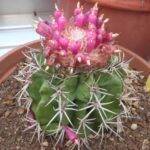
Overall, Melocactus are quite robust plants and if well cultivated they are not subject to adversity in a different way than other cacti. They are certainly particularly sensitive to water stagnation, especially in winter, therefore it is advisable, with these plants, to always have a light hand when it comes to watering. A phenomenon that frequently affects Melocactus (and which can happen with any cacti, albeit less frequently) is the loss of the root system. Often, even without apparent causes, in the absence of parasites and without having repotted, the roots of Melocactus go into “tilt”. It almost always happens with specimens equipped with cephalium and when we realize it, it’s too late to intervene: the stem dehydrates, deflates and despite watering it does not regain volume. The problem is that a plant with a cephalium seems almost incapable of reforming its root system. In other words, no matter how much care we give to the specimen (flaring it, cleaning the roots, removing the dry ones, placing the plant on pumice), the touchy Melocactus always seems to prefer a slow agony rather than reforming the roots and starting again, as does the most cacti. The sad consequence is that the specimen can remain alive even for two or more years, until the water reserves accumulated inside the stem are completely consumed…
SUBSCRIBE TO THE SITE – If you liked this article, subscribe to the site to have unlimited access to all the contents for one year or three months depending on the formula you choose. Here you will find terms and conditions.
SUBSCRIBE TO THE NEWSLETTER – If you want to receive the free newsletter every time new content is published, fill in the fields at this link!
Correlated articles
Culivation cards in pdf
How to save a cactus without roots
Cacti and succulents: seasonal care
Distribution of cacti and succulents: maps
Growing with Seramis
© The texts, videos, photos and graphic elaborations of the site “Il fiore tra le spine” are original material and are covered by copyright. It’s forbidden to reproduce them in any way.


